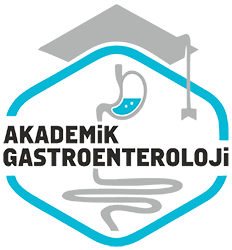Aralik 2009
Tip II Oddi sfinkter disfonksiyonunda biliyer manometri yapmadan sfinkterotomi uygun bir yaklasim midir?
Is it appropriate to perform sphincterotomy without biliary manometry in sphincter of Oddi dysfunction Type II?
- Ana Sayfa
- Sayılar
- Aralik 2009
- Tip II Oddi sfinkter disfonksiyonunda biliyer manometri yapmadan sfinkterotomi uygun bir yaklasim midir?...
Özet
Giriş ve Amaç: Oddi sfinkter disfonksiyonu Oddi sfinkteri?nin organik veya fonksiyonel anormalligine bagli ortaya çikan biliyer ve/veya pankreatik obstrüksiyonda görülen tablodur. Epizodik biliyer agri ile beraber safra kanal genisligi ve enzim yüksekligi olan tipinde (Tip I) endoskopik biliyer sfinkterotomi Hastaların çogunda etkili olmaktadır. Sadece agrinin olduğu grupta (Tip III) ise sadece sfinkter basinci yüksek bireylerde sfinkter ablasyonu etkili olduğu için, sfinkterotomi öncesi manometri önerilmektedir. Agri ile beraber sadece enzim yüksekligi veya sadece kanal genisligi olan grupta (Tip II) ise sfinkterotomi öncesi manometri gerekliliği tartismali bir konudur. Bu çalışmada Tip II Oddi sfinkter disfonksiyonu olan Hastaların endoskopik sfinkterotomiye (ES) yani- ti arastirilmıştır. Gereç ve Yöntem: Temmuz 2005-Eylül 2008 tarihleri arasında Tip I ve II Oddi sfinkter disfonksiyonu tanısı konulmus olan Hastaların prospektif olarak toplanan verileri retrospektif olarak değerlendirildi. Islemin basarisi, komplikasyonlari, endoskopik sfinkterotomiye biliyer agrinin yaniti arastirildi. Bulgular: Bu süre içinde 30 hasta [27 kadın, 3 Erkek, ortalama yaş: 58.6±18.3 (25-88) yıl] Oddi sfinkter disfonksiyonu tanısı aldi. Hastaların 18 (% 60)?i Tip I, 12?si Tip II Oddi sfinkter disfonksiyonu idi. Hastaların 24 (% 80) tanesi kolesistektomili idi. Alti (%20) hastanın papillasi fibrotikti. Onsekiz hastanın safra yollari selektif kanülize edilirken, oniki hastada selektif kanülasyon için önkesi yapilmasi gerekti. Daha sonra tüm hastalarda endoskopik sfinkterotomiye tamamlandi. Tüm hastalarda islem basarili oldu. Bir (%3.3) hastada islem sonrasi hafif şiddette pankreatit gelisti. Hastalar ortalama 21.4±10.8 (2-38) ay izlendiler. Tip I grubunda 15 (%83.3) hastanın semptomlarının tekrarlamadigi, 3 hastanın (%16.7) ise semptomlarının sürdügü, Tip II grubunda 8 (%66) hastanın semptomlarının tekrarlamadigi, 4 (%34) hastanın ise semptomlarının sürdügü saptandi. Bu hastalar ayrintili sorgulandiginda semptomlarının diğer fonksiyonel gastrointestinal hastalık semptomları ile örtüstügü saptandi. Sonuç: Tip I Oddi sfinkter disfonksiyonu olan hastalarda endoskopik sfinkterotomiye yüksek oranda etkilidir. Bu hastalarda manometri yapilmadan endoskopik sfinkterotomiye önerilebilir. Serimizde biliyer pankreatit orani bu hastalar için literatürde verilenden düşüktür. Verilerimizin sonuçlarına dayanarak Tip II Oddi sfinkter disfonksiyonu olan hastalarda endoskopik sfinkterotomiye cevap daha düşük olsa bile, bu hastalara, biliyer manometrinin yüksek pankreatit riski nedeniyle, dogrudan endoskopik sfinkterotomiye yapilmasi mantikli gibi görünmektedir.
Abstract
Background and Aims: Sphincter of Oddi dysfunction is the circumstance seen in biliary and/or pancreatic obstructions caused by functional or structural abnormalities in the sphincter of Oddi. Endoscopic biliary sphincterotomy is an effective therapy in most of the patients with type I Sphincter of Oddi dysfunction, which includes an episodic biliary pain, a dilated extrahepatic bile duct and biliary enzyme elevations. The presence of only pain indicates type III Sphincter of Oddi dysfunction, and endoscopic sphincterotomy is effective especially in those with high sphincter pressure. For this reason, sphincter of Oddi manometry is proposed in type III Sphincter of Oddi dysfunction. The necessity of sphincter of Oddi manometry before sphincterotomy remains controversial in type II Sphincter of Oddi dysfunction, which has biliary pain along with a dilated extrahepatic bile duct or biliary enzyme elevations. In this study, it was aimed to evaluate the response to endoscopic sphincterotomy in patients with type II Sphincter of Oddi dysfunction. Materials and Methods: The data obtained prospectively from patients with type I and II Sphincter of Oddi dysfunction between July 2005 and September 2008 were retrospectively investigated. The success and complications of papillotomy and the response of biliary pain after endoscopic sphincterotomy were ascertained. Results: During this period, 30 patients [27 female, 3 male, mean ± SD age: 58.6 ± 18.3 (25-88) years] were recognized as having Sphincter of Oddi dysfunction. Eighteen patients were classified as type I and remaining patients as type II Sphincter of Oddi dysfunction. Six (20%) patients had fibrotic sphincter of Oddi. Selective biliary cannulation was done in 18 patients, but 12 patients required needle-knife pre-cut before selective biliary cannulation. Later, the endoscopic sphincterotomy was completed in all patients, and all procedures were successful. Postprocedural mild pancreatitis was described in only one patient (3.3%). The patients were followed-up for a mean 21.4±10.8 (2-38) months. In the type I Sphincter of Oddi dysfunction group, no recurrent symptoms were established in 15 (83.3%) patients, but continuous symptoms were defined in 3 (16.7%) patients. In the type II Sphincter of Oddi dysfunction group, no recurrent symptoms were established in 8 (66%) patients, but continuous symptoms were defined in 4 (34%) patients. When these patients were investigated in detail, it was found that their symptoms were consistent with the other functional gastrointestinal diseases. Conclusions: Endoscopic sphincterotomy is a highly effective procedure in patients with Sphincter of Oddi dysfunction type I. endoscopic sphincterotomy without sphincter of Oddi manometry can be recommended in these patients. In our group of patients, the frequency of biliary pancreatitis was lower than found in the literature. According to our data, although endoscopic sphincterotomy-related symptomatic relief is low in type II Sphincter of Oddi dysfunction, it is logical to perform endoscopic sphincterotomy directly because of the pancreatitis risk due to sphincter of Oddi manometry.



